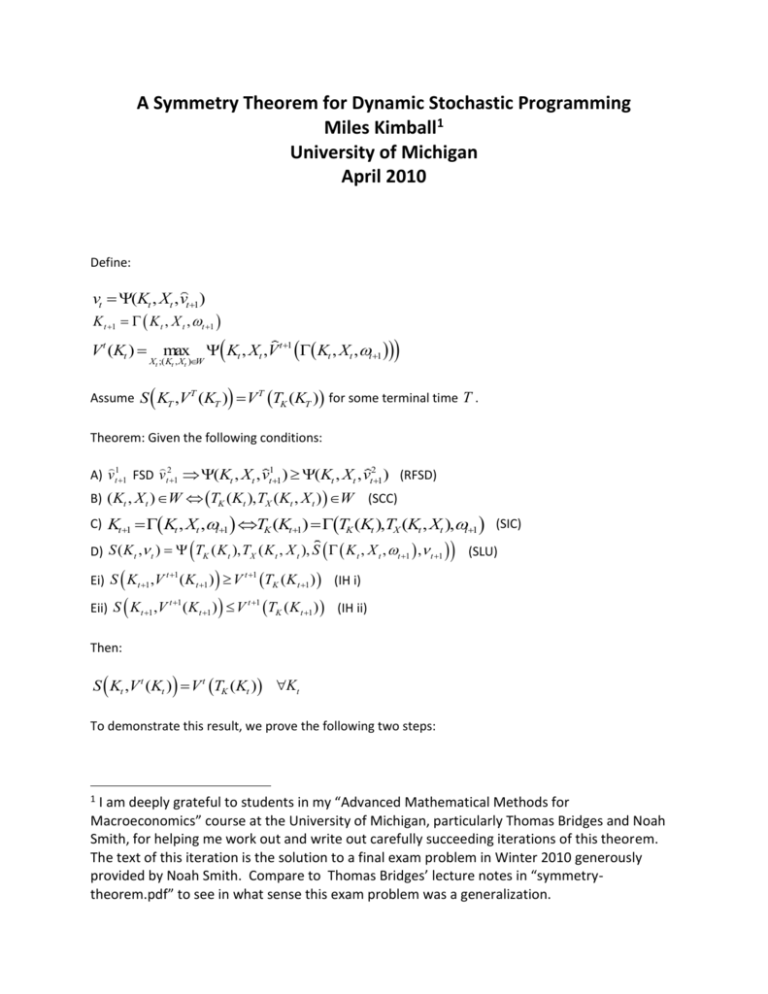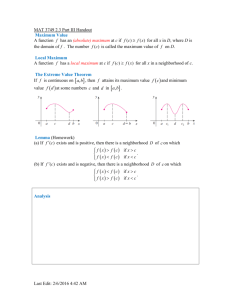symmetry-theorem-201.. - University of Michigan
advertisement

A Symmetry Theorem for Dynamic Stochastic Programming Miles Kimball1 University of Michigan April 2010 Define: vt (Kt , Xt , vt1) K t 1 K t , X t , t 1 V t (Kt ) max Xt ;( Kt , Xt )W Kt , Xt ,V t 1 Kt , Xt ,t 1 Assume S KT ,V T (KT ) V T TK (KT ) for some terminal time T . Theorem: Given the following conditions: A) v t11 FSD v t21 (Kt , Xt , vt11 ) (Kt , Xt , vt21 ) (RFSD) B) (Kt , X t ) W TK (Kt ), TX (Kt , X t ) W (SCC) C) Kt1 Kt , Xt ,t1 TK (Kt 1) TK (Kt ),TX (Kt , Xt ),t 1 (SIC) D) S ( K t , t ) TK ( K t ), TX ( K t , X t ), S K t , X t , t 1 , t 1 Eii) S K ) V T (SLU) t 1 t 1 Ei) S Kt 1 ,V ( Kt 1 ) V TK ( K t 1 ) (IH i) t 1 ,V t 1 ( Kt 1 t 1 K ( K t 1 ) (IH ii) Then: S Kt ,V t (Kt ) V t TK (Kt ) Kt To demonstrate this result, we prove the following two steps: 1 I am deeply grateful to students in my “Advanced Mathematical Methods for Macroeconomics” course at the University of Michigan, particularly Thomas Bridges and Noah Smith, for helping me work out and write out carefully succeeding iterations of this theorem. The text of this iteration is the solution to a final exam problem in Winter 2010 generously provided by Noah Smith. Compare to Thomas Bridges’ lecture notes in “symmetrytheorem.pdf” to see in what sense this exam problem was a generalization. i) V t TK (Kt ) S Kt ,V t (Kt ) 0 Kt ii) S Kt ,V (Kt ) V TK (Kt ) 0 Kt t t Step (i): Define: X * arg max Kt , X t ,V t 1 Kt , X t , t 1 X t ; Kt , X t W Lemma (L1): u(x) v(x)x u( X ) FSD v ( X ) Proof: a, v( X ) a u ( X ) a a, X ; v( X ) a X ; u( X ) a a, P u ( X ) a P v( X ) a u ( X ) FSD v ( X ) Now we write: V t TK ( K t ) S K t ,V t ( K t ) max X t ;TK K t , X t W TK ( K t ), X t ,V t 1 TK ( K t ), X t , t 1 S K t , max K t , X t ,V t 1 K t , X t , t 1 X t ; K t , X t W TK ( Kt ), TX ( Kt , X * ), V t 1 TK ( Kt ), TX ( Kt , X * ), t 1 S Kt , Kt , X * ,V t 1 Kt , X * , t 1 using (SCC) using (SIC) and (SLU) T K , X , TK ( Kt ), TX ( K t , X * ),V t 1 TK Kt , X * , t 1 TK ( Kt ), TX ( K t , X * ), S K t , X * , t 1 ,V t 1 0 using (IH i), (L1), and (RFSD) Step (ii): To prove (ii), it is sufficient to show that S TK 1 Kt ,V t TK 1 Kt V t Kt 0 Kt * K t t 1 Assume that both TK 1 and TX 1 exist. Define: X * arg max Kt , X t ,V t 1 Kt , X t , t 1 X t ; Kt , X t W Lemma (L2): TK Kt 1 TK ( Kt ), TX ( Kt , X t ), t 1 TK 1 Kt 1 TK 1 (Kt ), TX 1 (Kt , X t ), t 1 Proof: Taking TK 1 of both sides of the RHS gives us Kt , Xt ,t 1 TK 1 TK (Kt ),TX (Kt , Xt ),t 1 Now take Kt TK 1 ( Kt ) and (Kt , Xt ) TX 1(Kt , Xt ) . This yields: TK 1 (Kt ), TX 1 (Kt , Xt ),t 1 TK 1 Kt 1 Now we write: S TK 1 Kt ,V t TK 1 Kt V t Kt S TK 1 Kt , max TK 1 Kt , X t ,V t 1 TK 1 Kt , X t , t 1 1 X t ;TK Kt , X t W Kt , X * ,V t 1 Kt , X * , t 1 S TK 1 K t , TK 1 K t , TX 1 K t , X * ,V t 1 TK 1 K t , TX 1 K t , X * , t 1 Kt , X ,V * t 1 K , X * t , t 1 S TK 1 Kt , TK 1 Kt , TX 1 Kt , X * , V t 1 TK 1 Kt , X * , t 1 Kt , X ,V * t 1 K , X , * t Kt , X ,V t 1 K , X , * t t 1 0 by (IH ii), (L1), and (RFSD) This completes the proof of the Generalized Symmetry Theorem. using (SCC) using (SIC) and (L2) t 1 Kt , X * , S TK 1 Kt , X * , t 1 ,V t 1 TK 1 Kt , X * , t 1 * using (SLU)











